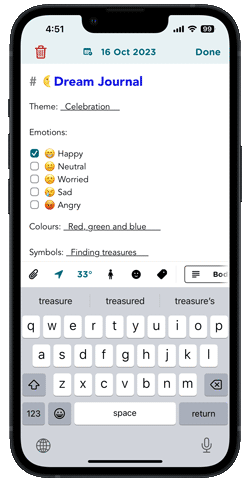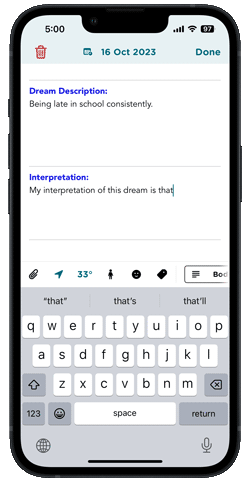How To Keep A Dream Journal?
Keeping a dream journal can be a transformative practice, enabling us to dive deeper into the realm of our subconscious and unravel the hidden messages within our dreams. Here are some valuable tips to help you embark on the journey of keeping a dream journal.

Dreams are windows to our innermost thoughts, desires, and fears. Often fleeting and quickly forgotten, they hold immense potential for self-discovery and personal growth. Keeping a dream journal is a powerful tool to unlock the secrets of our subconscious mind and tap into the wisdom of our dreams. In this article, we will explore the art of maintaining a dream journal and offer practical tips to help you embark on this transformative journey.
Create the Right Environment for Dream Journaling
Setting the stage for successful dream recording begins well before you even go to bed at night. By incorporating specific practices before bed, you can enhance your dream recall and create an environment conducive to vivid dreaming. Here's what you can do:
1. Dedicate a peaceful, comfortable space for journaling
Photo by Stephanie Harvey / Unsplash
Creating a conducive environment for dream journaling can greatly enhance your experience. Choose a quiet and comfortable space where you can relax and focus on your thoughts. This designated area could be a cozy corner in your bedroom, a comfortable chair by a window, or any place that instills a sense of tranquility. Ensure that you have ample lighting and enough privacy to delve into your thoughts without distractions.
2. Make an intention to remember your dreams before falling asleep
Photo by Daniel Ramírez / Unsplash
Setting an intention is a powerful tool to encourage dream recall. Before you drift off to sleep, take a moment to affirm your desire to remember your dreams when you wake up. Simply repeat a sentence or phrase, such as "I will remember my dreams tonight," or "I am open to receiving and remembering my dreams." By reinforcing this intention and focusing your mind on remembering, you increase your chances of recalling dreams upon waking.
3. Keep a pen, notebook, or a dream journal app
Having a means to record your dreams is essential for maintaining a dream journal. Choose a method that suits your preferences and lifestyle. A traditional pen and notebook are reliable and offer a tangible connection to your dreams. Keep them by your bedside within easy reach, ensuring that you can quickly jot down your dreams as soon as you wake up, before they fade away. If you prefer a digital approach, use Journey's dream journal template available for smartphones, offering convenience and the ability to include multimedia elements like voice recordings or images.

Whichever method you choose, make sure it is easily accessible and ready to use. By having the necessary tools at hand, you eliminate any barriers or excuses that might hinder you from recording your dreams promptly.
The goal is to seamlessly integrate dream journaling into your routine, making it a habitual practice. By dedicating a peaceful space, setting an intention, and having the right tools by your side, you set the stage for a successful dream journaling experience that captures the essence of your dreams.
Develop Dream Recall Techniques
Upon awakening, it's crucial to capture the details of your dreams before they fade away. Consider these techniques:
1. As soon as you wake up, lie quietly and try to recall as much of your dream as possible
When you first awaken, remain still and allow your mind to drift back to the dream world. Take a few moments to mentally review your dream, grasping onto any fragments of memories or visuals that come to mind. It's essential to do this before external distractions or daily responsibilities cloud your recollection.
2. Pay attention to emotions, colors, people, places, and any significant events
To fully capture the essence of your dream, focus on the details that stood out to you. Emotions play a vital role, as they are often intensified during dreams. Pay attention to the range of feelings you experienced, whether it was joy, fear, confusion, or excitement. Additionally, note any prominent colors, people, locations, or significant events that occurred throughout the dream. These elements help provide context and facilitate later interpretation which will be filled in the dream journal template within the Journey app.

3. Capture the main storyline, but don't worry about organizing everything perfectly
As you begin recording your dream in your journal or on your preferred medium (notebook or Journey's dream journal app), don't worry about constructing a perfect narrative. Instead, aim to capture the main storyline or the key events that transpired. Focus on concise phrases or bullet points that summarize the dream's progression. Organizing everything perfectly can sometimes hinder the flow of ideas and memories, so it's best to prioritize gathering information first.
Write in a Stream-of-Consciousness Style
Embrace a stream-of-consciousness style of writing, where you let your mind wander and explore the depths of your dream without any restrictions. Don't pressure yourself to write with perfect grammar or sentence structure. Instead, focus on capturing the raw essence of your dreams:
1. Use descriptive language to paint a vivid picture of your dream
Photo by Alex Williams / Unsplash
When writing in a stream-of-consciousness style, focus on using descriptive language to bring your dream to life on paper. Be specific and detailed in your descriptions, as this will help you recall the visuals and events from your dream. For example, instead of simply stating that you were in a garden, describe the vibrant colors of the flowers, the sound of birds chirping, and the feeling of soft grass beneath your feet.
2. Include sensory details that stood out to you
Photo by Mohammad Alizade / Unsplash
Dreams often engage all our senses, so it's important to include sensory details that stood out to you. Did you encounter any distinct smells, tastes, or textures in your dream? Maybe you remember the smell of freshly baked cookies or the taste of a tangy fruit. Including these sensory details will further immerse you in the dream and make it easier to recall in the future.
3. Don't shy away from emotions or any personal reflections that arise during the recording process
Dreams can evoke a wide range of emotions, from joy and excitement to fear and sadness. As you write in a stream-of-consciousness style, express any emotions that arose during the dream or even any personal reflections that come up while recording it. Did the dream make you feel anxious? Were you overwhelmed with happiness in.
Reflecting In a Dream Journal & Seek Insight
Journaling your dreams is just the first step; reflection adds depth to the process. Reflecting on your dreams allows you to explore the deeper aspects of your psyche. It opens a pathway to understanding your fears, desires, and unresolved conflicts. You can consider these strategies:
1. Set aside time regularly to review your dream journal entries
To make the most of your dream recall efforts, establish a regular practice of reviewing your dream journal entries. Set aside dedicated time, such as once a week or month, to revisit your dreams and reflect on them. You can use Journey's app reminder feature to remind you during your next journaling session to review your dreams, facilitating the development of a consistent journaling habit. This will help you spot patterns, recurring symbols, and themes that may provide valuable insights into your subconscious mind.

2. Analyze your dreams, looking for connections and possible meanings
Photo by Anton Darius / Unsplash
When reviewing your dream journal entries, take a closer look at the content of your dreams and analyze them. Look for connections between different dreams or recurring symbols and themes. Consider how these elements might relate to your experiences, emotions, or challenges in your waking life. For example, if you consistently dream about being late, it could signify a fear of not meeting expectations or feeling overwhelmed by time constraints.

3. Stay curious and open-minded
Photo by Skye Studios / Unsplash
Approach your dreams with a sense of curiosity and open-mindedness. Recognize that your dreams can provide profound insights into your subconscious mind and can offer a different lens through which to understand yourself. Avoid dismissing or discounting your dreams as mere randomness. Instead, stay open to the possibility of hidden meanings and be willing to explore different interpretations and perspectives.
A dream journal serves as a bridge between our conscious and unconscious minds, allowing us to explore the hidden depths of our psyche. Through consistent recording, reflection, and interpretation of our dreams, we gain powerful insights, tap into our creative potential, and embark on a journey of self-discovery. Implement the tips provided in this guide, and begin unlocking the vast reservoir of wisdom that lies within your dreams. Allow your dream journal to become a treasure trove of personal growth and transformation. Start today with Journey's dream journal app and unveil the secrets of your remarkable inner world, one dream at a time.








